The best bait for sea fishing is the prey that the target fish eats themselves. Effective and well-loved popular saltwater baits considered the best are mackerel, Pacific saury, menhaden, sea worms, shrimp, squid, crabs, mussels, herring, clams, and sprats. Fresh bait is considered the best.
“Match the Hatch” is a saying amongst anglers indicating you need to use bait representing the diet of the fish species you’re targeting. Fish use highly developed senses such as scent, sound, and movement when hunting prey, and closely mimicking what they typically eat on your hook will lead to more catches. What is the best bait for sea fishing?
Choosing the right bait depends on what type of fish species you’re targeting. The best baits for sea fishing include ones that attract many types of fish; however, certain fish species have preferences when dining out. Want to catch a sailfish? Drop the squid and hook live ballyhoo!
What Is The Best Bait For Sea Fishing?
The best bait for sea fishing will largely depend on what type of fish species you’re hunting or targeting.
Luckily for anglers, many bait options are available that will attract many types of fish without being too specie specific, which enhances the overall chance of catching fish. The best sea fishing baits are the following:
- Mackerel pike, aka Pacific saury (bluey)
- Mackerel
- Menhaden (bunker)
- Sea Worms such as bloodworms, ragworms, and lugworms
- Shrimp
- Shellfish such as crabs, clams, and mussels
- Squid
- Prawn
- Mussels
- Sprats
- Cut up pieces of fish
- Shad
- Mullet
- Pilchards
- Ballyhoo
- Eels
5 Sea Fishing Baits For Beginners
When starting on your sea fishing journey, whether from the beach, inshore, or out on the deep blue, you must use bait that guarantees the best success of hooking fish consistently. Bait that will get the fish, and you, hooked on the experience.
Here are 5 of the best sea fishing baits for beginners:
1.Mackerel Pike (Bluey), Mackerel, And Menhaden (Bunker)
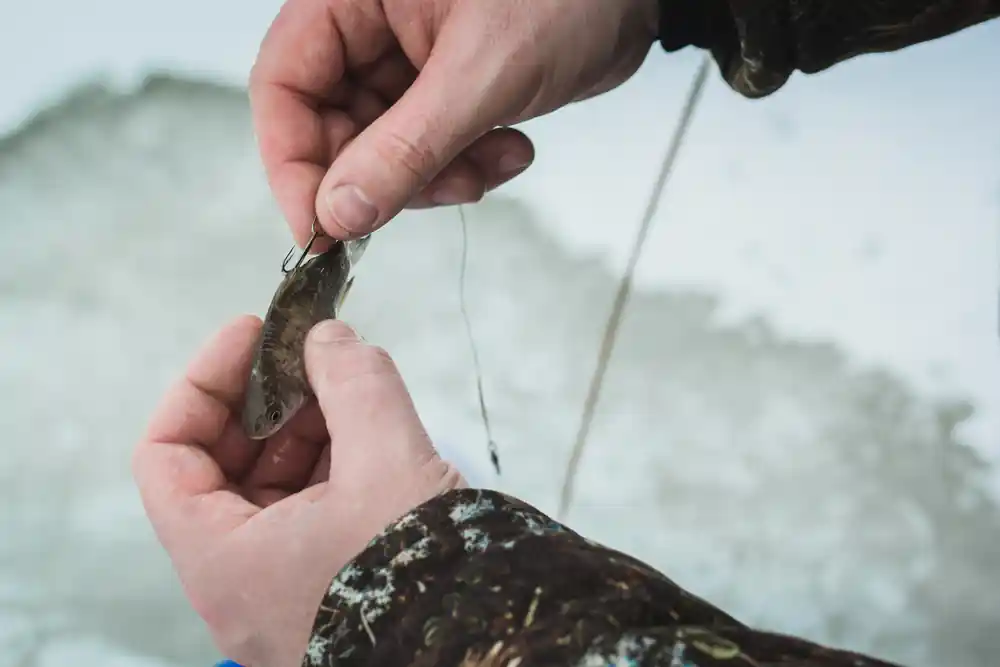
The best bait is typically a fish that’s extra oily. Popular oily fish used as live bait, cut bait, or frozen bait includes the following:
⦁ Mackerel pike, aka bluey aka Pacific saury, is an extremely potent sea fishing bait due to its high oil content, which helps to spread its scent for many miles. If you had to choose one bait for a fishing trip, choose bluey, as it catches most ocean fish, and its flesh and texture aren’t soft like other oily fish such as sardines and herring.
⦁ Mackerel is an angler favorite with high success rates with many different fish species and an excellent bait for turbot or cod fishing from the beach. It can lose some of its stinkiness when frozen, so fresh mackerel should be your first choice when bottom or float fishing. Thawed mackerel can go bad quickly, so it needs to be kept cold to be effective.
⦁ Menhaden (bunker) is an oily fish found inshore during summer and offshore during winter months, and are prey to many species such as bluefish, flounder, mackerel, tuna, striped bass, and sharks. Whether used as live or cut bait, the smell and oil content make for a very attractive bait, and where there’s a school of bunkers, cast your line immediately, as they bring in big fish.
Mackerel has a tough skin that makes it a durable bait on your hook and can be cast long distances, surviving for a long time on the hook. When hooking mackerel, be careful not to hook them too deep, as the hook point may have trouble pulling through the skin when struck by a fish.
When working with Pacific saury (bluey), you must be careful not to get it on your clothes as it will take a long time for the pungent smell to evaporate. The downside of using bluey is that crabs love it and will go for it as much as any fish, so beware when using bluey for bottom fishing.
2.Sea Worms
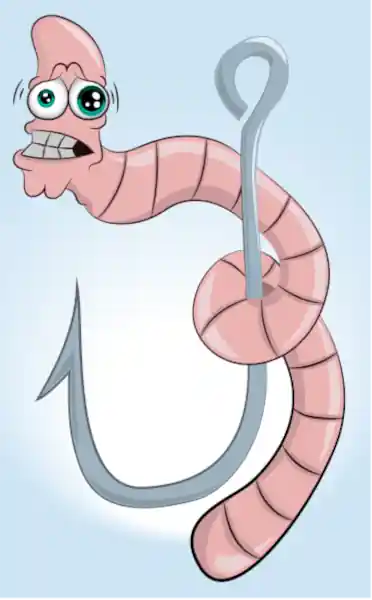
Marine worms, such as the bloodworm, the ragworm, and the lugworm, are effective baiting options when fishing in the ocean. Fish find the smell, color, and movement of these worms attractive, and not many fish species turn up their snouts for a juicy worm.
⦁ Bloodworms are legendary sea fishing bait. Armed with an especially salty smell and a body that represents a blood color, fish love them. The blood and organs are visible through the bloodworm’s translucent skin, attracting fish like bluefish, sea trout, striped bass, and flounder.
Funnily enough, bloodworms are armed with teeth and will try to draw blood when being hooked up, so be careful not to be bitten by these bright red fish morsels. When fishing in murky saltwater, the brighter-colored bloodworm is easier spotted than the brownish ragworm.
⦁ Ragworms, commonly called clam, mussel, and sandworms, are sea fishing bait loved by anglers worldwide. On a day when nothing seems to bite, it’s usually advantageous to have a couple of this tentacled millipede-crossed-with-a-worm in your tackle box.
Fish like flounder, surf perch, whiting, blackfish, sea trout, and rockfish love themselves a bite of ragworm. They wiggle on the hook, creating movement that attracts many fish species, making it a popular and successful sea fishing bait.
Ragworms are available at most tackle and bait shops worth their salt. Typically, you’ll use smaller hooks when fishing with ragworms, increasing your chance of catching porgy, perch, and flounder.
⦁ Lugworms, commonly called rock worms, can grow up to 12′ and are popular sea fishing bait. It’s estimated that the average sandy beach is 30% lugworm, and you can tell by a wriggly sand pile where they are on the beach.
It’s a versatile bait that works well with other baits such as squid, a firm favorite of cod (whole worm setup), and flounder (cut into sections). Many bait shops sell black lugworms. When handling lugworms, be wary of the iodine it secretes, as it takes some scrubbing to get off.
Lugworms are soft bait and a crab favorite, so pairing them with a more durable bait such as tough squid will ensure you’re fishing even when the lugworms get picked off. Decomposing lugworms can be repugnant, so be careful when transporting them in your vehicle.
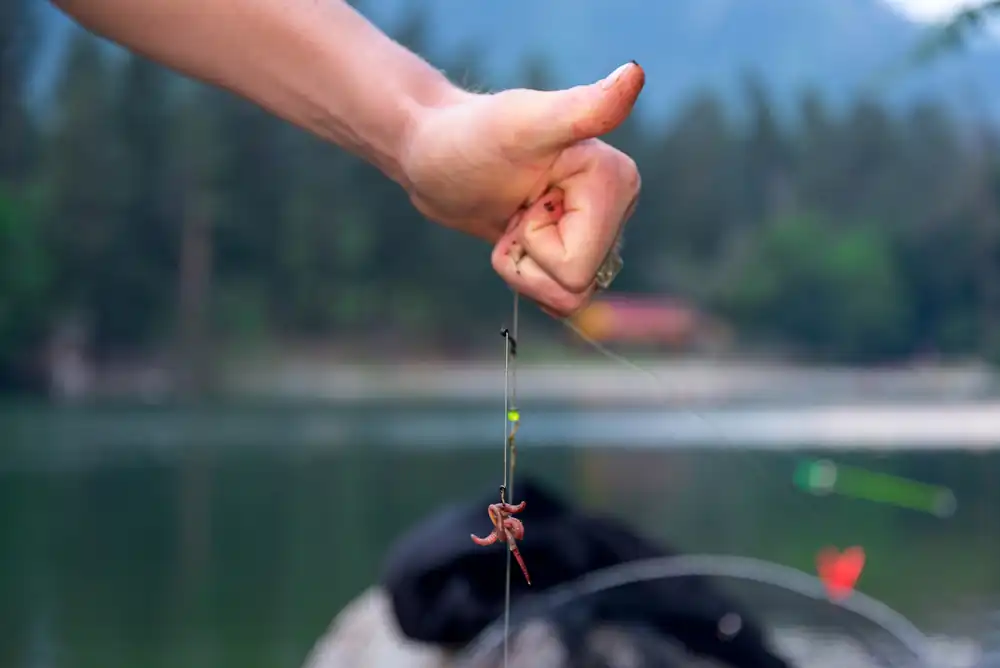
3.Shrimp
Known as a great all-rounder in the bait world, shrimp attracts a host of sea creatures. Alive or dead, shrimp has a distinct odor many fish can’t resist, especially redfish, jacks, snapper, and grouper.
Removing shell pieces from the shrimp’s body will enhance the scent in the water.
Shrimp is an excellent bait option when fishing from the shore or near the shore from bridges, piers, or boats. When you ask for shrimp, bait shops may offer you Mantis Shrimp (sea lice). Sea lice are a type of shrimp and can be used as bait.
It would help to cover leftover shrimp with salt before you freeze them. The salt draws out the moisture, which gives it a more robust texture when you use it in the future, making baiting much easier.
Shrimp tails work best when fishing from the shore.
4.Shellfish
Shellfish in some way or form on your fishing hook tends to lead to fishing success. Crabs, clams, and mussels give you various bait options that have been tried and tested in salty waters. Grouper and cobia love shellfish.
Crab baiting options are hard-shell, soft-shell, and peeler crabs. Hooking a whole crab is an effective bait option as its movement will attract larger fish species.
Peeler crabs are in the process of ridding themselves of their old shell to form brand-new ones. These crabs are aware of their vulnerability when “peeling” off their protective shell, so they hide during this stage.
Peeler crab bait gives you the advantage of not worrying about crabs stripping your hook of bait, as crabs don’t tend to go for crab meat.
Peeler crab bait is expensive and can be limited in supply compared to other bait types. Fish hunting by sight doesn’t always “fall” for peeler crab. You might be less successful in catching pollock and mackerel when using peeler crab. For most other species, especially cod, it works beautifully.
Should you find shellfish like clams and mussels while fishing, take them out of their shell, and let them bake in the sun for a bit. The sun will harden the flesh, making it easier to secure the typically soft flesh on your hook.
Sand crabs are best used when surf fishing as many fish feed on them along the shoreline. Spotfin croaker, yellowfin croaker, and corbina love sand crabs.
5.Squid
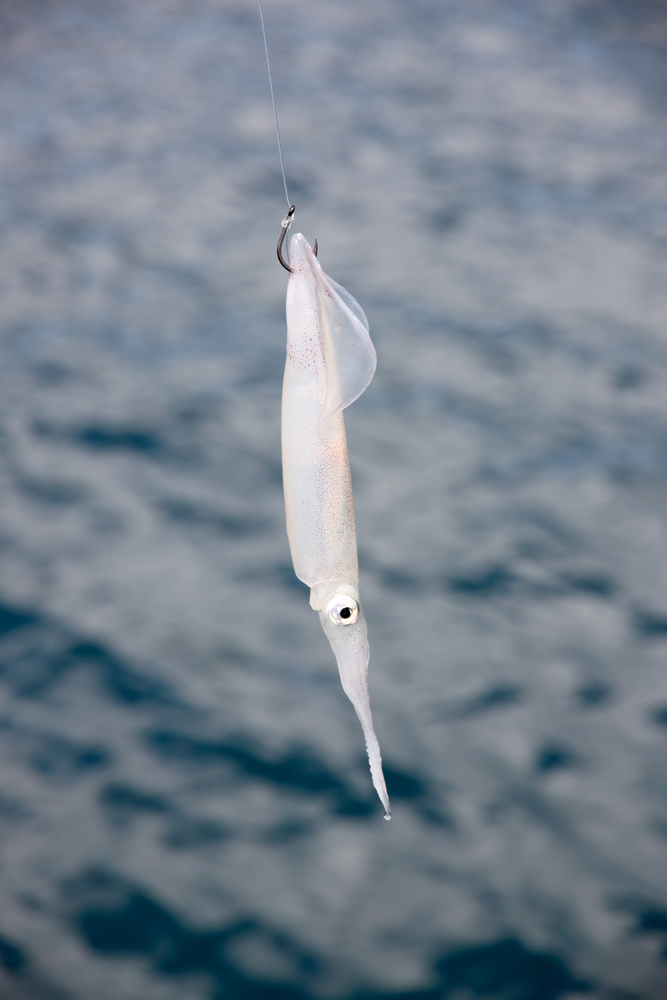
Squid is a durable and beloved sea fishing bait. With squid, you give yourself more baiting options as you can cut the squid into appropriate sizes or use the whole squid as bait, depending on what fish you want to catch.
When using whole squid, you must run the fishing line through the inside of the squid’s mantle (outer body shell) and hook the squid in the head. The tentacles and white flesh make it an attractive proposition for many a fish.
Cutting up squid mantle into strips is another way to use parts of it as bait. Squid is a versatile bait used in several fishing methods, such as trolling, bottom fishing, and floating rigs, and works well in partnership with most other baits when applied in a cocktail of baits.
Squid can go bad quickly out at sea, so you’ll need to keep it cold while in the bait bucket.
How To Bait Up For Sea Fishing With Fresh Bait
When fishing with live or fresh bait, it’s important to hook the bait up correctly. But before you hook the fresh bait on, you must ensure it stays fresh until needed. Storing live fish in a bucket with an aerator is one way of keeping fish alive if you don’t have access to a live well.
For fresh bait, the best advice is to keep it on ice and in a dark, cooler box. Some anglers will tell you to lay the fresh meat in rough salt to preserve it longer.
When live baiting, the following baiting methods work well:
⦁ Live baiting with bait fish: Put the hook through the mouth and out behind the gills or in the back behind the dorsal fin. Many anglers will hook the bait fish through the tail to encourage a forward swimming movement and through the mouth and gills to get them to swim downward. Trolling with bait fish requires you to hook the fish under the jaw, through the jaw, or both nostrils.
⦁ Fishing with live sea worms: Thread the worm along the hook until the whole hook is covered except for the barbed point. For larger worms, pierce the hook through a few points in its body, leaving a piece at the end to wriggle freely.
⦁ When fishing with live shrimp: When hooking up live shrimp, you must try not to puncture the black spot close to the head, as this will kill the shrimp instantly. Placing the hook beneath the shrimp’s head, so the barb comes out on top is one way of baiting up. When bottom fishing with shrimp, you must insert the hook from the top, working the point beneath the black spot before bringing the barb out.
How To Bait Up For Sea Fishing With Frozen Bait
When you’re using frozen bait, allowing the bait to thaw overnight is recommended. Place the frozen bait in newspapers outside your house and allow nature to do its thing. Frozen bait, when thawed, is typically used whole (prawns, shrimp, mussels) or as cut bait.
Cut bait generally refers to cutting fish pieces into required bait sizes, such as strips, chunks, or fillets. Typically, you do this with the smaller fish you catch during the day. However, you can cut your frozen bait similarly when thawed.
When trolling thawed (previously frozen) bait, it’s recommended that you cut the bait into strips, hooking it through the thicker part of the bait so that the thinner part can imitate a moving fish.
When hunting bigger game fish, you can hook whole heads or tails. Smaller fish-like sprats can be hooked through the top lip and the fish skull, which normally does the trick.
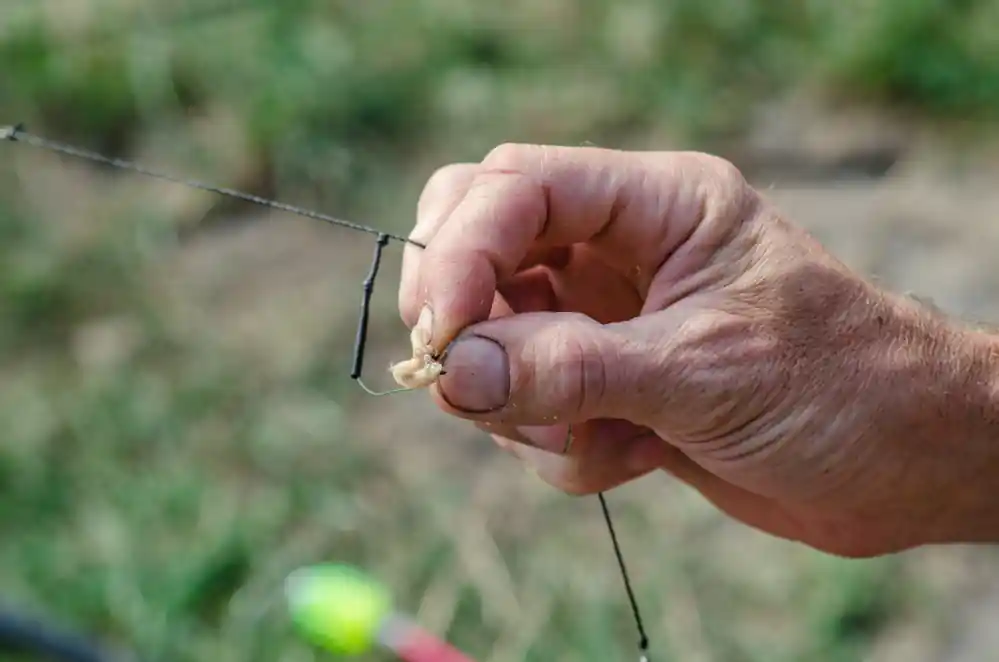
4 Best Sea Fishing Bait From A Supermarket
Every angler has run out of bait at some time and had to make the trip to the local supermarket for reinforcements. You’ll be pleasantly surprised at how effective sea fishing bait purchased at a supermarket can be.
Here are some of the best sea fishing baits you can forage from your local supermarket:
1.Prawns
When choosing sea fishing bait at your local supermarket, mackerel often finds the bottom of the shopping cart. When mackerel isn’t available, you won’t do yourself a disservice by choosing prawns as bait.
Prawns attract a lot of fish and can assist you in landing a variety of fish species. Uncooked prawns are your best bet if you’re after bigger fish, whereas cooked prawns work well on smaller species found at piers and docks.
No harm in catching smaller fish species; they make excellent live bait. When faced with an option between raw and cooked, always take the raw prawns as they represent what fish eat the most.
If frozen prawns are the only option, you must keep them fresh by storing them in a cooler or bucket packed with ice packs. Adding additives such as rock salt and mussel powder will help firm up the soft flesh of the prawn, making it easier to hook up.
If the prawn flesh is soft and mushy, use bait elastic to fasten it more securely to the hook.
2.Mussels
Mussels make great bait. When purchasing mussels from the supermarket, you must try to get ones not found in a complementary sauce combination. You want them to release their unique smell into the water, not some lemon-garlic-tomato sauce.
Let frozen mussels thaw a little before using them. Should you experience problems with mussels (don’t want to stay attached to the hook), employ some bait elastic to ensure adherence. With a little preparation, these bulking baits are a cod favorite.
Mussels work best when added with other baits. If the supermarket is fresh out of mussels, you can collect your own at low tide. Mussels freeze well and can add value as a baiting option.
3.Sprats
“Sprats” is the collective name given to several small species of forage fish belonging to the Clupeidae family that are typically very oily. Pilchards, sardines, and anchovies are often loosely referred to as “sprats,” They all make for excellent bait options.
These small oily fish are often on sale and can be used as whole or cut bait, depending on your target fish. Sprats can be frozen and kept as emergency bait or used as fresh bait, depending on how the supermarket sells them.
Halibut loves frozen anchovies.
4.Herring
Herring is found at most supermarkets worth their salt and is a popular fishing bait due to the huge amount of oil it releases. Herring catches a great variety of fish and can be used as cut bait in different-sized chunks depending on the species you want to get biting.
4 Best Homemade Sea Fishing Bait
Here are 4 easy methods to make homemade sea fishing bait to see you through when your bait stock is running low. Some of them work so well that you’ll stick with them.
1.Shrimp Gelatin Bait
The following recipe requires a few items and is a cost-effective way when making homemade bait that is robust and extremely pungent. Here are the ingredients required:
⦁ Unflavored gelatin
⦁ Food colorant (pink, neon orange, or chartreuse)
⦁ Berkley Gulp! Alive! Shrimp Fish Attractant
Take ½ cup of water and mix in an ounce of the shrimp extract. Bring the concentrate to a rolling boil in a pot on the stove. Add 3 tablespoons of unflavored gelatin and cook until it becomes a smelly syrup.
Add the food colorant as the syrup cooks down and stir continuously. Pour the syrup mixture into the designated mold compartments (big ice cube tray or brownie sheet) and put it into the fridge. When the concentrated stock hardens, remove it from the mold and cut it into strips.
Store it in a freezer bag and use it as required. The cubes should have a very pungent smell. You can make your own bait fish stock by adding two cups of water to a pot before adding shrimp. Cook 10 minutes before draining the stock through a coffee filter to savor the shrimp-infused liquid stock.
2.Flour Salmon/Mackerel Bait
An easy and inexpensive method of making a DIY salt and freshwater bait is by using the following ingredients:
⦁ The leftover liquid from a tin of salmon or mackerel should typically fill ¼ cup
⦁ 9 tablespoons of flour
⦁ Optional food coloring to match the color of the prey of the species of fish you’re planning to target
Mix the ¼ cup of fish juice with the flower. Add 8 drops of food coloring (pink or a red and yellow combination) to mimic something like pink prawns. Mix all the ingredients before cutting them into bait pieces.
Place the chunks in a zip lock bag and into the freezer. The bait is soft and not made for trolling or casting long distances from the shoreline. The bait does well when dropped from a pier or boat.
3.Fresh Cream Cheese And Ground Fish Bait
The following recipe is an easy one to try out. Results may differ depending on where you fish.
Ingredients required:
⦁ Fresh small fish (sardines, pilchard, anchovies, sprats)
⦁ Flour
⦁ Cream cheese
⦁ Oil
Grind the fish and mix it with regular cooking oil. Adding fish attractant oil to the mix will ensure the scent attracts fish.
Add cream cheese and mix the ingredients thoroughly. Add flour to get a nice and thick texture. Roll it into a ball and leave it overnight. The following day forms the desired bait shapes from the mixture, hook them up, and cast them away.
You can use bait elastic to ensure the bait stays on the hook longer.
4.Diet-Pepsi-Soaked Shrimp
The recipe is super easy. Buy a big bottle of diet Pepsi. Take fresh, not mushy shrimp, and cut off the heads and tails. Drop the shrimp’s middle sections into the bottle and leave it overnight in the fridge.
Fish seem to love whatever chemical process happens in the Pepsi bottle, and you will catch fish with this modified bait. The shrimp will present a little tougher and with a slightly different brown color. It works if you work it.
Conclusion
Anglers are often spoilt for choice when it comes to sea fishing bait. Shrimp, mackerel, Pacific saury, peeler crab, prawns, mussels, sprats, herring, and a range of cut-up fish make excellent bait, as there’s always that one fish that will eat almost anything.
The best advice for fishing is to entice the target fish with the food sources they prey on. If you “match the hatch,” your chances of catching fish increase tenfold. Fresh is best, but frozen will do the job too.
Resources
https://www.britannica.com/animal/rag-worm
https://a-z-animals.com/blog/sprats-vs-sardines-what-are-the-differences/